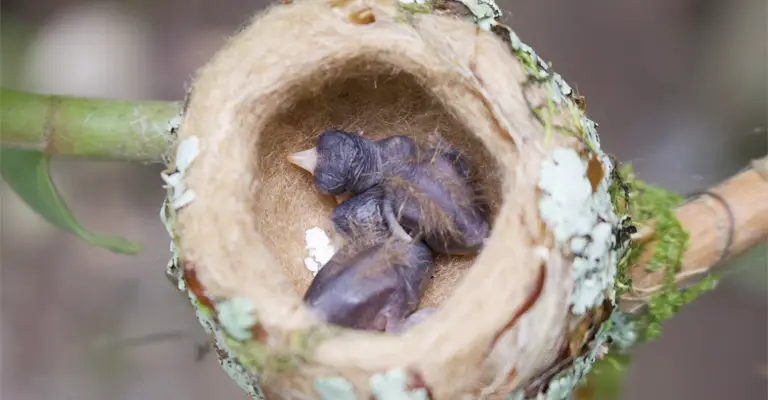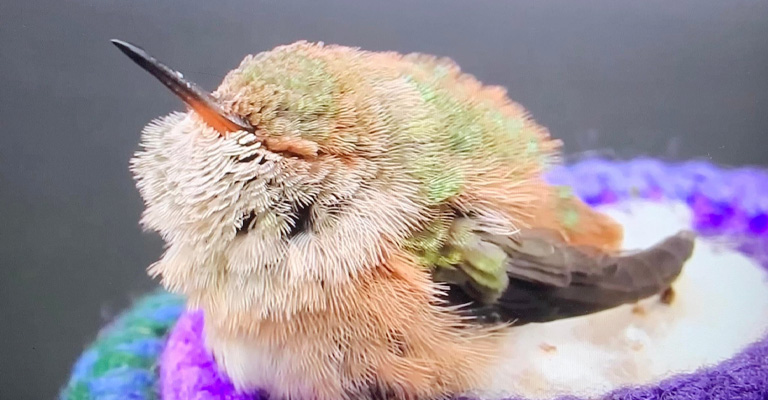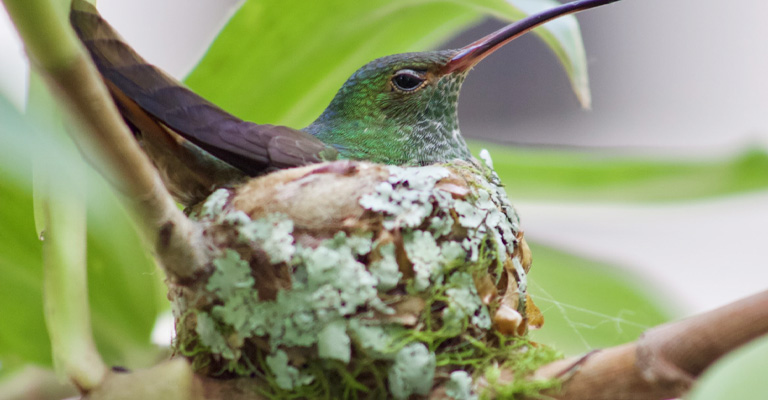Hummingbirds are captivating creatures, renowned for their vibrant plumage and astonishing aerial maneuvers. While these tiny dynamos are a common sight at nectar feeders and flowers, you might have noticed something peculiar – the apparent absence of baby hummingbirds.
In this exploration, we unveil the secrets behind ‘Why do you never see baby hummingbirds’. Hummingbird nests, often hidden away in trees or shrubs, are marvels of miniature engineering.
The momentous task of incubating and nurturing hummingbird chicks unfolds with incredible swiftness and secrecy. Their small size, rapid growth, and well-concealed nests make spotting baby hummingbirds a rare occurrence.
Join us as we delve into the intricacies of hummingbird reproduction, the challenges they face as nestlings, and the fascinating adaptations that keep these elusive hatchlings hidden from prying eyes.
Discover why, despite their ubiquitous presence in our gardens, spotting a baby hummingbird remains a true rarity.

Why Do You Never See Baby Hummingbirds?
In this section, we will unravel the mysteries behind this phenomenon and shed light on the captivating, hidden world of baby hummingbirds.
The Enigma of Baby Hummingbirds
One of the most remarkable aspects of hummingbird life is their rapid and seemingly elusive transition from nestling to fully-fledged adult.
Adult hummingbirds are often seen flitting about, sipping nectar from flowers and feeders, engaging in fierce territorial disputes, and performing their signature mid-air acrobatics.
Yet, baby hummingbirds remain hidden from view for a significant portion of their early lives. Understanding why this is the case requires a closer look at the intricacies of hummingbird reproduction and nesting habits.
Tiny Nests in Hidden Places
Hummingbirds are meticulous architects when it comes to their nests. These tiny birds construct their nests using a combination of plant material, spider silk, and other fine fibers, creating structures that are barely larger than a walnut shell.
The nests are often placed high in trees or shrubs, further adding to the challenge of spotting them. The purpose of these hidden nests is twofold: protection and concealment.
The Precarious Lives of Nestlings
Hummingbird chicks, or nestlings, face numerous challenges during their early days. As they grow, their voracious appetites demand a constant supply of nectar and insects, which parent hummingbirds diligently provide.
However, this sustenance comes with a price – the risk of predation. Nestlings are vulnerable to a wide range of predators, including snakes, birds of prey, and even other hummingbirds.
To mitigate this danger, hummingbird parents are vigilant in guarding their nests, swooping down on potential threats with remarkable speed and aggression.
Rapid Growth and Development

One of the reasons baby hummingbirds seem to vanish from sight is the astonishing speed at which they grow and develop. A typical hummingbird nestling hatches from an egg that is roughly the size of a pea and quickly progresses through a series of developmental stages.
Their rapid growth, combined with the care provided by their parents, means that they spend a relatively short time in the nest.
Within just a few weeks, a baby hummingbird transforms from a featherless, helpless hatchling into a fully-feathered fledgling, ready to venture into the world.
This rapid development further limits the window of opportunity for observers to catch a glimpse of these elusive young birds.
Nesting Behavior and Parental Care
Hummingbird parents exhibit remarkable dedication to their offspring. The mother typically incubates the eggs and broods the nestlings, keeping them warm and protected from the elements.
The father plays a role in defending the nest and providing food. This division of labor allows for efficient care and protection of the nestlings.
Hummingbird parents feed their young a diet of regurgitated nectar and insects, ensuring that the chicks receive the essential nutrients for growth.
The feeding process is precise and frequent, with parents making numerous trips to gather food and deliver it to their hungry offspring.
The Hidden World of Baby Hummingbirds
While baby hummingbirds may be elusive, their concealed existence is a marvel of nature. The secretive world of hummingbird nests, with its delicate construction, rapid growth, and vigilant parental care, showcases the adaptability and resilience of these tiny birds.
As observers, it is essential to respect the privacy of these birds during the nesting and fledgling phases. Disturbing a hummingbird nest or attempting to handle the chicks can have detrimental consequences.
Instead, we can revel in the wonder of knowing that these hidden treasures exist in our gardens, nurturing the next generation of hummingbird flyers.
The Thrilling First Flight
As baby hummingbirds reach the final stages of their development, they prepare for their inaugural flight. Fledglings emerge from the nest, often perching on nearby branches.
Their first flights are wobbly and uncertain, but with practice, they quickly refine their flying skills.
Once the fledglings become proficient flyers, they join the ranks of their adult counterparts, engaging in the familiar behaviors of feeding at nectar-rich blooms and defending territories.
At this point, they become visible to human observers, and their presence adds to the enchantment of the hummingbird-filled landscapes we cherish.
What Can I Do to Find Baby Hummingbirds?

Spotting baby hummingbirds can be a challenging but rewarding endeavor. These tiny, delicate creatures are often well-concealed in their nests, hidden high in trees or shrubs.
However, with some patience, observation skills, and a few strategic efforts, you can increase your chances of encountering baby hummingbirds in the wild. Here are some tips to help you find these elusive avian wonders.
Learn About Hummingbird Behavior
To find baby hummingbirds, it’s essential to understand their nesting and parenting behavior. Hummingbird nests are typically located in sheltered spots, often high in trees or shrubs.
These nests are well-constructed and camouflaged, making them challenging to spot. Adult hummingbirds are also very protective of their nests, so you’ll need to be discreet and respectful.
Know the Nesting Season
Baby hummingbirds are most likely to be found during the breeding and nesting season, which varies depending on your location and the specific species of hummingbirds in your area.
In North America, for example, this season generally occurs in the spring and early summer. Knowing when to look for nests can significantly increase your chances of spotting baby hummingbirds.
Observe Adult Behavior
Adult hummingbirds can provide valuable clues about the presence of baby hummingbirds nearby.
If you notice adult hummingbirds repeatedly visiting a specific area or flowerbed, it’s possible that they have a nest nearby. Watch their flight patterns and observe where they disappear into shrubs or trees.
Look for Nest Sites
Hummingbirds prefer to nest in well-concealed locations, often choosing the forked branches of trees or shrubs. They may also use hanging baskets, porch eaves, or other sheltered spots.
Scan trees and shrubs for small, cup-shaped nests made of plant material, spider silk, and other fine fibers. Nests are typically about the size of a walnut shell.
Be Patient and Observant
Finding baby hummingbirds requires patience and keen observation skills. Spend time quietly observing areas where you suspect a nest may be located.
Watch for any subtle movements or sounds coming from the nest, as baby hummingbirds may make faint chirping noises when they are hungry or being fed by their parents.
Use Binoculars or a Camera with a Telephoto Lens
Binoculars or a camera with a telephoto lens can be invaluable tools for observing baby hummingbirds from a distance without disturbing them. These optical aids allow you to get a closer look at nests and adult hummingbirds without getting too close.
Avoid Disturbance
It’s crucial to prioritize the well-being of baby hummingbirds and their parents. Avoid any actions that could disturb or stress them.
Do not approach nests too closely, as this can cause adult hummingbirds to abandon their young. Keep a respectful distance, and resist the temptation to touch or handle the nestlings.
Create a Hummingbird-Friendly Garden
Attracting hummingbirds to your garden can increase your chances of encountering baby hummingbirds.
Plant nectar-rich flowers, such as salvia, trumpet vine, and fuchsia, to provide a food source for adult hummingbirds. The presence of adults may lead to nesting activities in your garden.
Set Up Hummingbird Feeders
Hummingbird feeders can also attract adult hummingbirds to your yard. Ensure that the feeders are clean and filled with a sugar water solution (four parts water to one part sugar) during the nesting season.
The presence of hummingbirds in your yard may lead to the discovery of nearby nests.
Install Nesting Material
Consider placing hummingbird-friendly nesting material in your yard. You can hang pieces of fine string, cotton, or spider silk in suitable locations. Adult hummingbirds may use these materials to construct their nests, increasing the chances of finding nests in your vicinity.
Educate Yourself
Learning more about the specific species of hummingbirds in your area and their nesting habits can be immensely helpful. Different hummingbird species may have distinct preferences for nesting locations and behaviors. Knowledge about their unique traits can guide your search efforts.
Participate in Citizen Science Projects
Many birdwatching and citizen science organizations offer opportunities to report hummingbird nest sightings. By contributing your observations to such projects, you can help researchers gather valuable data on hummingbird populations and nesting habits.
FAQs
How can I tell if there are baby hummingbirds near my home?
To determine if baby hummingbirds are nesting nearby, observe the behavior of adult hummingbirds. Look for adult hummingbirds visiting the same location repeatedly, especially around shrubs, trees, or hanging baskets. Keep an eye out for any subtle movements or sounds coming from potential nest sites.
Is it safe to approach a hummingbird nest to get a closer look at the baby hummingbirds?
Approaching a hummingbird nest should be avoided, as it can cause stress and potentially lead to the abandonment of the nestlings by adult hummingbirds. It’s best to maintain a respectful distance and use binoculars or a camera with a telephoto lens to observe from afar.
What should I do if I find a baby hummingbird that appears to be in distress?
If you encounter a baby hummingbird that seems to be in distress or has fallen from the nest, it’s crucial to proceed with caution. If the nestling is visibly injured, contact a local wildlife rehabilitator or veterinarian for guidance.
How long does it take for baby hummingbirds to fledge and leave the nest?
The time it takes for baby hummingbirds to fledge, or leave the nest, varies depending on the species and environmental conditions. On average, it can take anywhere from 18 to 30 days from hatching to fledging.
What can I do to attract hummingbirds to my garden and potentially encourage nesting?
To attract hummingbirds to your garden and increase the chances of nesting, plant nectar-rich flowers such as salvia, trumpet vine, and fuchsia. Maintain clean hummingbird feeders filled with a sugar water solution (four parts water to one part sugar) during the nesting season.
Conclusion
The world of baby hummingbirds is a realm of remarkable adaptability and elusiveness. Their concealed nests, rapid growth, and well-coordinated parental care strategies ensure that they remain hidden from the watchful eyes of curious observers.
While we may frequently enjoy the vibrant presence of adult hummingbirds at our feeders and flowers, spotting their tiny offspring is a rare privilege.
These delicate nestlings face numerous challenges as they develop, from predators to the vagaries of weather. Their ability to navigate these hurdles and mature into full-fledged hummingbirds is a testament to the resilience of these avian wonders.
As we continue to marvel at the acrobatic displays and dazzling plumage of hummingbirds, let us also appreciate the hidden, delicate ballet of life that takes place within their concealed nests.
The mystery surrounding baby hummingbirds only serves to deepen our appreciation for these extraordinary creatures.